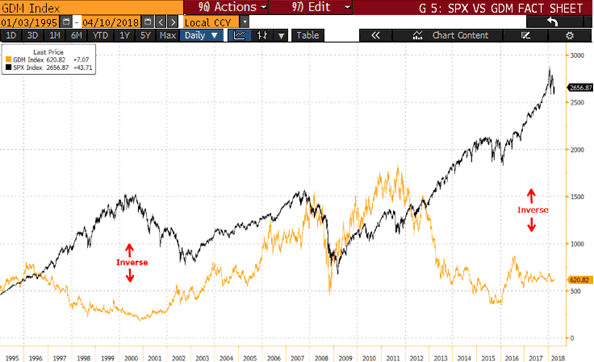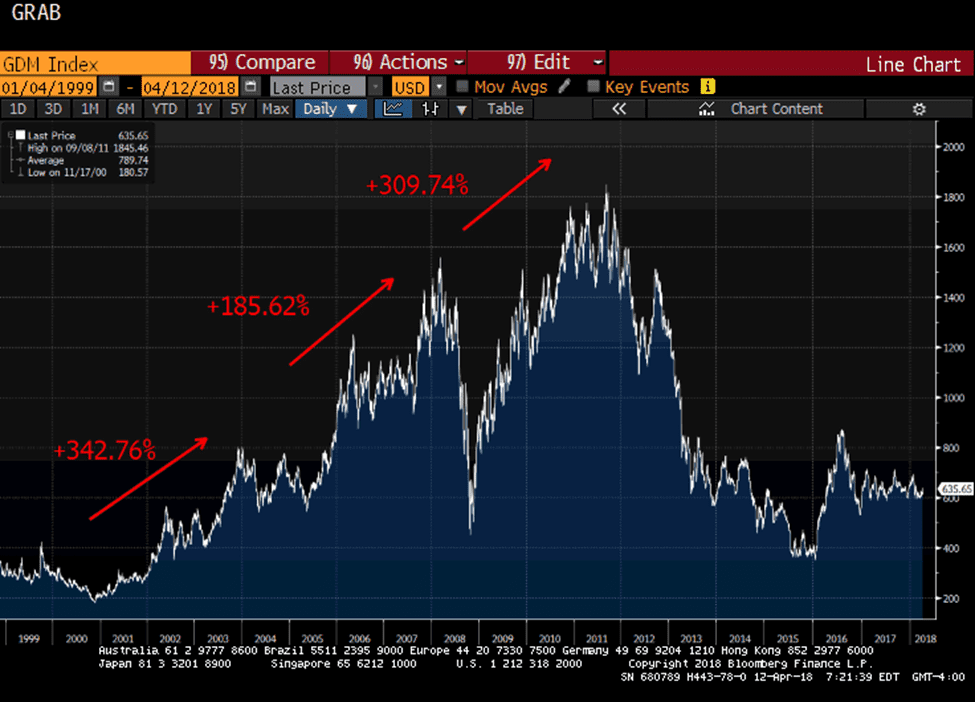At Sprott, we view investment merits of gold and gold shares as distinctly different. Gold offers the ability to remove investment capital from the traditional financial system at a moment’s notice. Gold shares, on the other hand, offer two important variations on the gold investment thesis. First, gold-mining equities provide well-documented torque to cyclical advances in spot gold. In essence, high-quality gold miners introduce a value-creation proposition to the secular opportunity of rising gold prices. Second, we believe gold shares represent a tactical portfolio allocation capable of generating significant alpha during periods in which excessive ebullience for U.S. financial assets is being recalibrated.
The beta-to-bullion reputation of gold equities is based on sound fundamentals. Gold mines involve significant fixed costs underpinning highly variable revenues. The math of a rising gold price implies strong profit leverage over both imbedded development and construction costs as well as ongoing costs of extraction. Additionally, a rising gold price can increase the proven-and-probable reserves of most mining companies, even in the absence of new discoveries. SEC accounting rules require that gold miners report their mineral reserves based only on the portion of their ore bodies which can generate profits at the prior-three-year-average gold price. As the gold price rises, miners convert their mineral resources to reserves based on their audited assumptions of profitability. Finally, a rising gold price fuels expanded corporate exploration budgets, in turn enabling the value creation of potential new discoveries. Because most gold is found close to existing deposits, a rising gold price reflexively enhances the value of miners’ existing land packages.
The obvious flipside of gold-share leverage is the fact that this gearing works in both directions. During extended periods of gold-price weakness, the investment merits of gold-mining companies can become increasingly challenged. Indeed, there are few market segments in which ongoing review of industry prospects, coupled with dynamic sizing of portfolio commitments, are more prudent.
$1,350 Breakout?
While gold shares are commonly viewed as harbinger for bullion’s prospects, there are many instances (such as during the bottoming process of spot gold in December 2015 followed by gold shares in January 2016), in which gold must take the lead to set the course for the gold complex. During the past five calendar quarters, spot gold has traded largely in a $150 trading range (between $1,200 and $1,350), with an average trading price ($1,272.64) very close to the range midpoint. Spot gold has now flirted with breakout above $1,350 on four occasions since September 2017. While gold shares’ relative valuation versus bullion rests near historic lows, largely eliminating downside risk for gold shares in a flat-bullion-price environment, we expect gold will need to break convincingly above $1,350 before animal spirits truly return to gold shares. When this occurs, however, gold shares are poised for an explosive move.
Improving Fundamentals
As the S&P 500 Index has set successive highs during the past two years, we believe generalist investors have failed to appreciate significant improvement in operating fundamentals and financial discipline in the gold-mining industry. Without question, many gold-miners practiced sloppy cost management and questionable capital discipline amid the ten-year gold-price advance through 2011. Several high-profile components of major gold indices became poster-children for disastrous corporate governance as the gold price receded from its highs. Industry impairments during 2012 and 2013 totaled almost $50 billion. The two-year span also marked the replacement of no fewer than 60 CEOs, CFOs and COOs in the gold-mining space. This revamping of expense, capital and project discipline has significantly augmented industry profitability, a fact not commonly appreciated by consensus.
We cite the august work of industry veteran David Haughton (CIBC) to lend perspective to the significant improvements in cost structures across the gold mining industry in recent years. In Figure 1, below, David plots the blended cost structures for the 47 gold mining companies in the CIBC gold-mining universe. Cash costs for the group have declined 12.7%, from their 2013 peak of $691 per ounce, to $603 in 2017. Adding in G&A, exploration and sustaining capex, all-in-sustaining-costs (AISC) for the group have declined 21.1% from their 2013 peak of $1,105, to $872 in 2017. Finally, throwing in development capex, interest and taxes, David estimates that all-in-costs-after-tax (AIC-AT) for his universe have declined 34.0%, from a 2012 high of $1,734, to $1,145 in 2017.

As David’s work demonstrates, the gold-mining industry has made significant strides improving virtually every relevant financial metric during the past five years. As a result of these across-the-board improvements in financial and operating performance, gold shares are generating free-cash-flows on par with those being created at peak gold prices.
Rock-bottom Valuations
Our interpretation of the listless 2017 performance of gold equities is that investors simply remain a bit gun-shy from painful share declines through 2015. Even during the steep run-up of first-half 2016, prominent gold-equity vehicles experienced only negligible capital inflows, and now the post-Trump gold correction seems only to have reinforced investor indifference towards the space. As a result, prominent gold miners still trade near their cheapest valuations in decades. As shown in Figure 2, below, the average price-to-NAV multiple for the 12 seniors in the Canaccord gold-miner universe has ranged between 0.51x and 1.40x since 2009, with an eight-year average of 0.82x. Today the blended price-to-NAV multiple stands at just 0.57x!

We believe gold miners represent an effective tactical portfolio allocation to generate performance alpha during corrective periods for overextended U.S. equity averages. As shown in Figure 3, below, there have been two periods in the past quarter-century of pronounced inverse correlation between the S&P 500 Index and the GDM Index: 1996-through-2002 and 2012-through-the-present. In the first instance, gold shares were literally left for dead as the internet bubble hit full stride through March 2000. Then, as the S&P 500 fell 52%, gold stocks tripled.
In the current episode, the S&P 500 and gold shares have (somewhat counter-intuitively) moved in precisely opposite directions ever since the Fed’s September 2012 announcement of QE3. During the first half of 2016, this gaping divergence finally appeared to be closing. Since the Trump election shock, gold shares have stabilized but the S&P 500 has resumed its upward trajectory. We expect the “jaws of life” divergence between the S&P 500 and gold equity indices to close with trademark gusto in the near future. Currently, the redeployment of a portion of general U.S. equity exposure to gold shares represents a non-consensus portfolio allocation with highly compelling logic.

Portfolio Alpha
Given contemporary apathy towards gold shares, we suspect most investors remain unaware of the significant degree to which gold shares have outperformed the S&P 500 Index during periods since 2000 when faith in U.S. financial assets has been challenged. As demonstrated in Figure 4, below, the three primary advances of gold shares during the past 17 years have generated aggregate returns which are nothing short of spectacular. Since 2000, the GDM Index has posted three roughly three-year advances totaling 342.76% (11/17/00-12/2/03), 185.62% (5/16/05-3/14/08), and 309.74% (10/27/08-9/8/11). Coincident performances for the S&P 500 Index during these three periods were a decline of 22.01%, an increase of 10.50%, and an increase of 39.70%.














